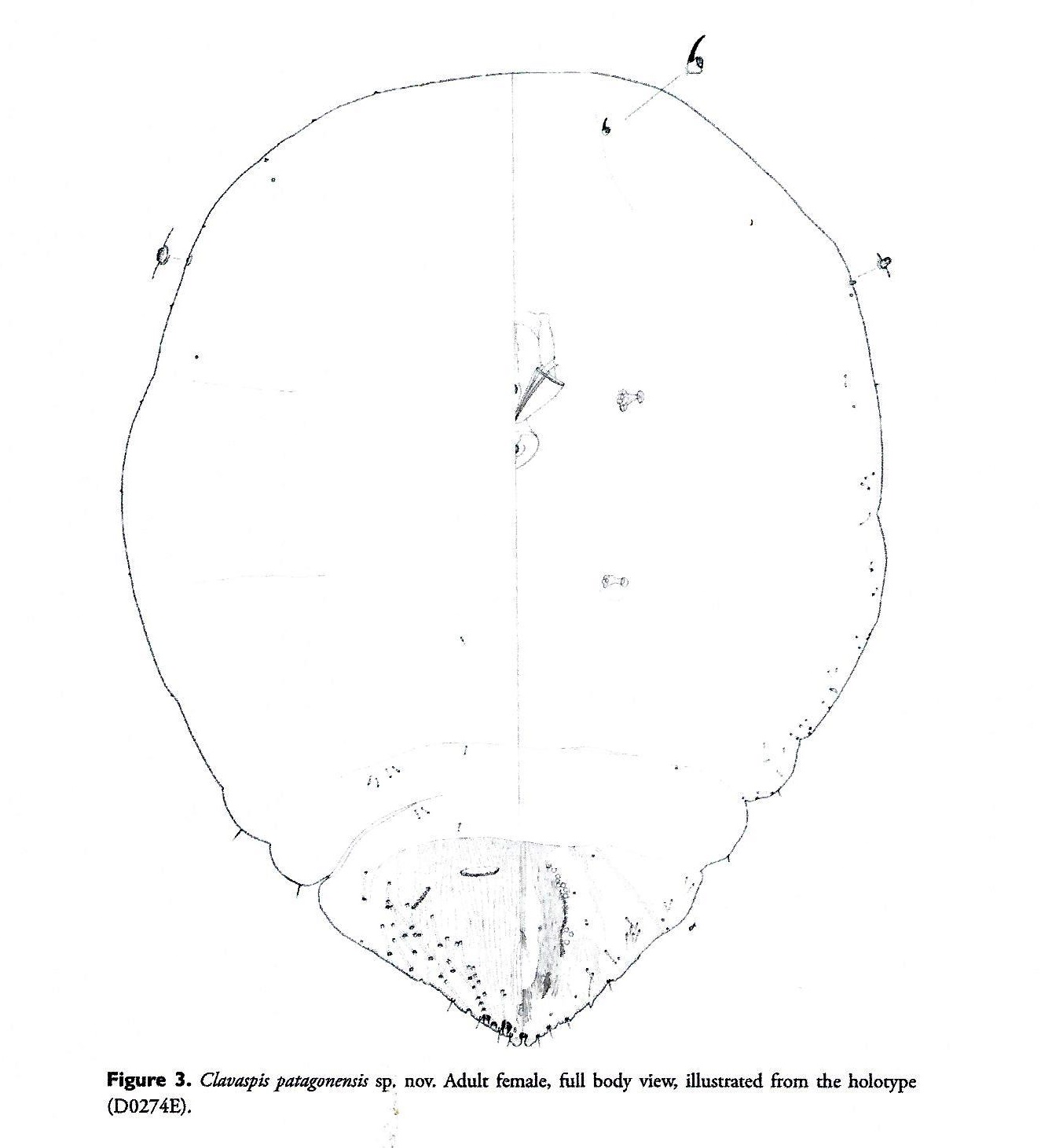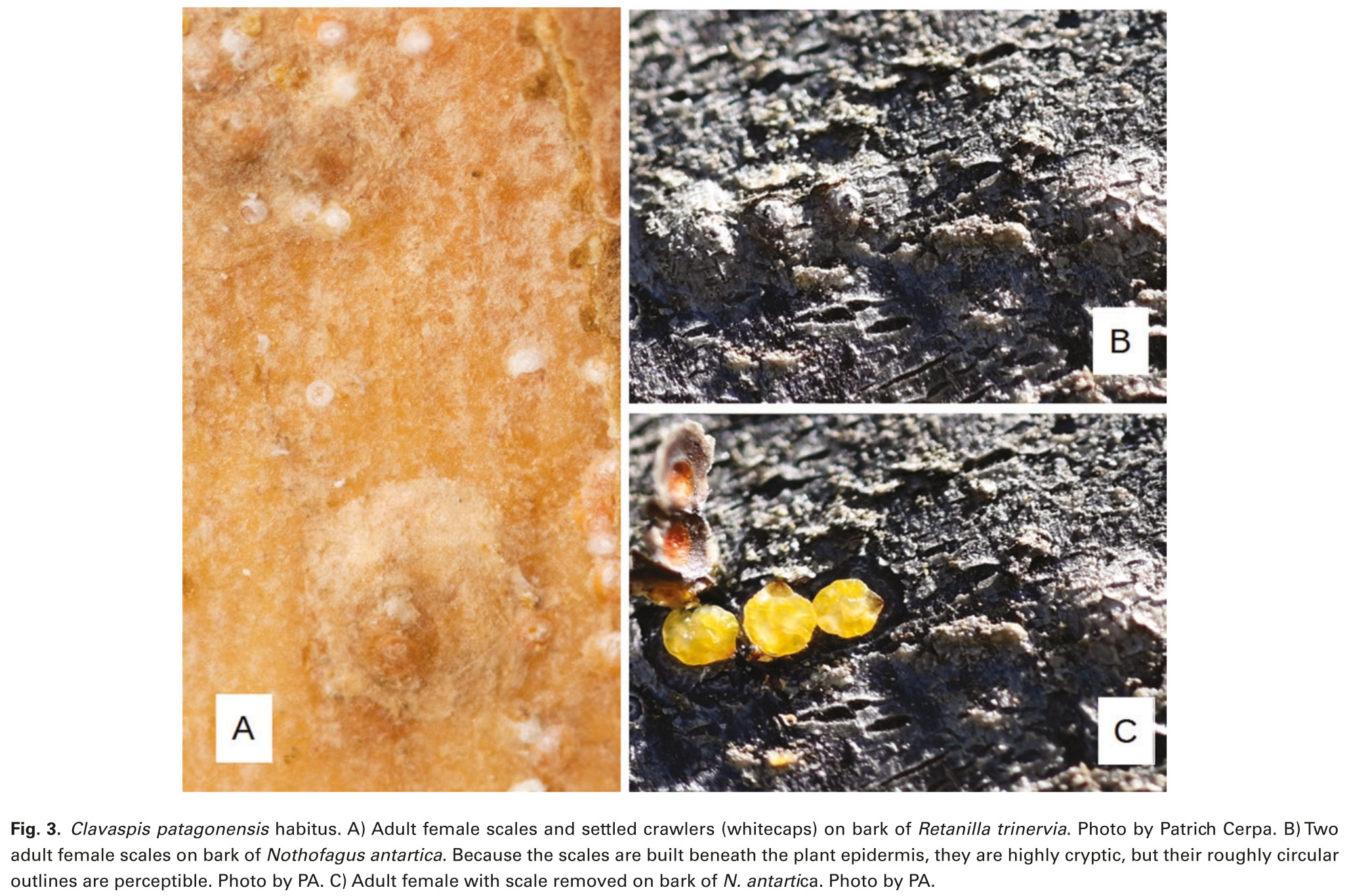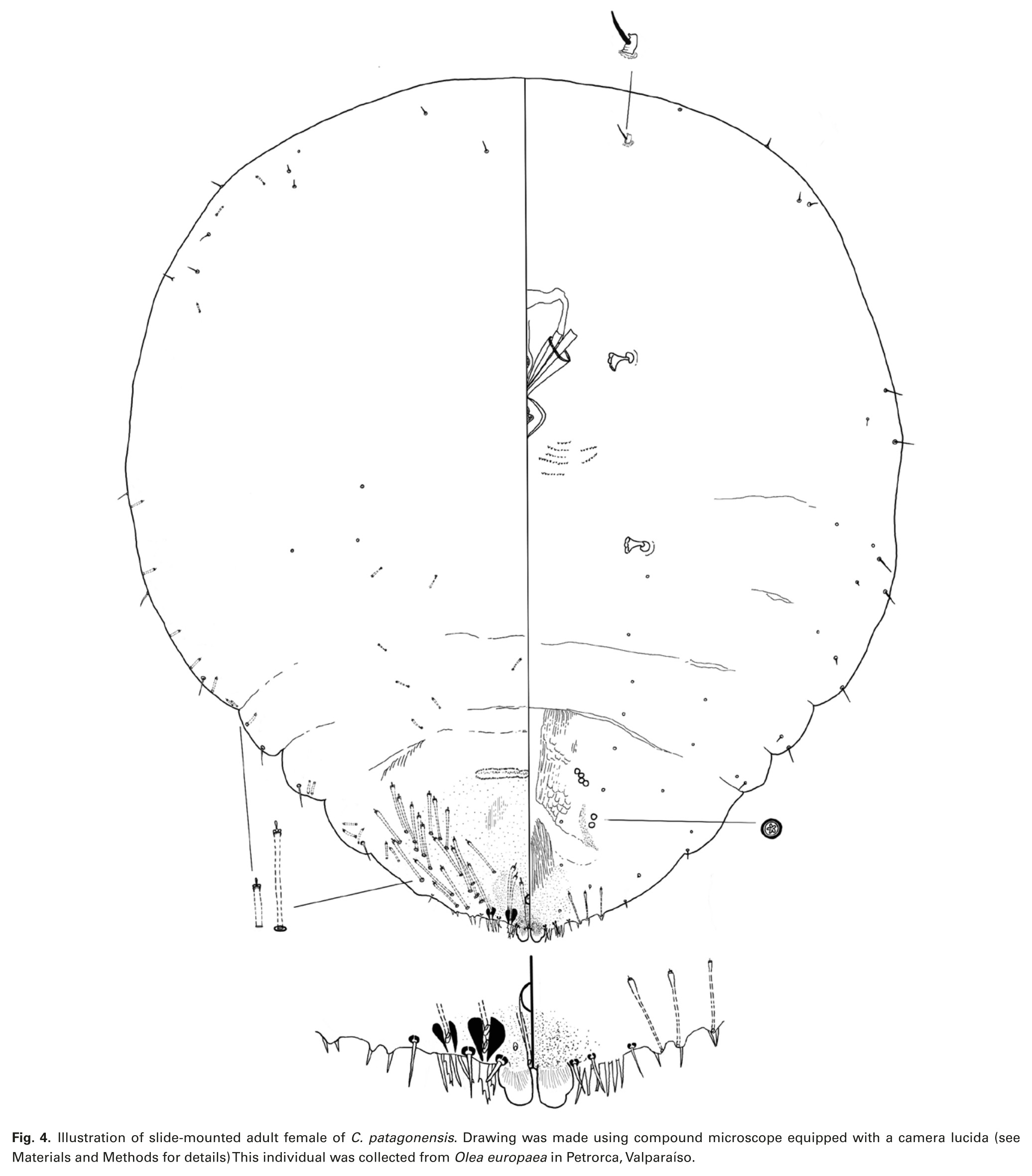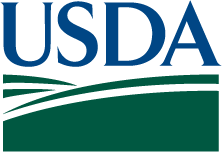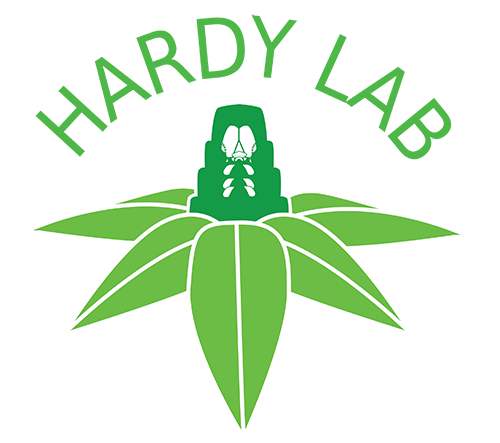Valid Names Results
Clavaspis patagonensis Schneider, Claps, Wei, Normark & Normark, 2020 (Diaspididae: Clavaspis)Nomenclatural History
- Diaspidiotus ancylus; González & Charlin 1968: 110. misidentification
- Diaspidiotus ancylus; González 2016: 30, 37, 45. misidentification
- Clavaspis undescr Schneider, et al. 2018. unavailable name that is placed
- Clavaspis ud0274 Normark, et al., 2019. unavailable name that is placed
- Clavaspis patagonensis Schneider, Claps, Wei, Normark & Normark 2020: 52. Type data: ARGENTINA: Neuquén, PN Lanin, Pucará; (40.15S, 71.63W); 11/28/2001; by L. Claps and L. Díaz Briz. Holotype, female, by original designation Type depository: Tucuman: Fundacion e Instituto Miguel Lillo, Universidade Nactional de Tucuman, Argentina; accepted valid name Notes: Paratypes: Argentina • 1 adult female; same slide as holotype; IFML (D0274E) • 1 adult female; same data as holotype; UMEC (D0274B) • 1 adult female; same data as holotype; USNM (D0274A). Illustr.
Common Names
- austral polyphagous scale NormarNoGa2025
- escama polífaga austral NormarNoGa2025
Ecological Associates
Hosts:
Families: 19 | Genera: 29
- Anacardiaceae
- Lithraea caustica | NormarNoGa2025
- Schinus molle | NormarNoGa2025
- Atherospermataceae
- Laurelia sempervirens | NormarNoGa2025
- Laureliopsis philippiana | NormarNoGa2025
- Ericaceae
- Gaultheria | NormarNoGa2025
- Escalloniaceae
- Escallonia | NormarNoGa2025
- Euphorbiaceae
- Colliguaja odorifera | NormarNoGa2025
- Fabaceae
- Robinia pseudoacacia | NormarNoGa2025
- Hydrangeaceae
- Hydrangea serrata | NormarNoGa2025
- Monimiaceae
- Peumus boldus | NormarNoGa2025
- Nothofagaceae
- Nothofagus antarctica | NormarNoGa2025
- Nothofagus betuloides | NormarNoGa2025
- Nothofagus dombeyi | NormarNoGa2025
- Nothofagus nitida | NormarNoGa2025
- Oleaceae
- Fraxinus | NormarNoGa2025
- Olea europaea | NormarNoGa2025
- Podocarpaceae
- Podocarpus nubigenus | NormarNoGa2025
- Saxegothaea conspicua | NormarNoGa2025
- Proteaceae
- Embothrium coccineum | SchneiClWe2020 NormarNoGa2025
- Lomatia hirsuta | NormarNoGa2025
- Quillajaceae
- Quillaja saponaria | NormarNoGa2025
- Rhamnaceae
- Colletia spinosissima | NormarNoGa2025 | (=Colletia spinosa)
- Retanilla ephedra | NormarNoGa2025
- Rosaceae
- Malus domestica | NormarNoGa2025
- Prunus persica | NormarNoGa2025
- Pyrus communis | ZamudiCl2005 NormarNoGa2025
- Salicaceae
- Azara | NormarNoGa2025
- Populus alba | NormarNoGa2025
- Salix viminalis | NormarNoGa2025
- Smilacaceae
- Smilax aspera | NormarNoGa2025
- Vitaceae
- Vitis vinifera | NormarNoGa2025
- Winteraceae
- Drimys winteri | NormarNoGa2025
Geographic Distribution
Countries: 2
- Argentina
- Entre Rios | NormarNoGa2025 ZamudiCl2005
- Neuquen | SchneiClWe2020
- Rio Negro | NormarNoGa2025
- Chile | Gonzal1989 GonzalCh1968
- Aisen (=Aysen) | NormarNoGa2025
- Atacama | NormarNoGa2025
- Biobio | NormarNoGa2025
- Coquimbo | NormarNoGa2025 PizarrAlBa2020
- La Araucania | NormarNoGa2025
- Los Lagos | NormarNoGa2025
- Los Rios | NormarNoGa2025
- Maule | NormarNoGa2025
- Metropolitana | NormarNoGa2025
- O'Higgins | NormarNoGa2025
- Valparaiso | NormarNoGa2025
Keys
- SchneiClWe2020: pp.67-71 ( Adult (F) ) [Aspidiotini in Argentina]
Remarks
- Systematics: http://zoobank.org/B7FD9835-4FAE-4CE0-8B8A-1E11DB6A4705 GenBank accession number KY218988.1; EF-1α, MH915713.1 and KY221285.1; COIII, MH916221.1 and KY220694.1; 16S of primary endosymbiont (Uzinura diaspidicola), KY220094.1 Molecular and morphological evidence both indicate that Chilean scale insect populations previously identified as D. ancylus actually belong to C. patagonensis. In C. patagonensis, the plates anterior to the seta marking segment VI, when present, are broad-based, with a central microduct orifice often flanked by one or two tines (simple, linear plates present in this position linear in D. ancylus); the paraphysis laterad of L1 is variable, often broadly clavate, sometimes with terminal knob directed medially (always moderately developed in D. ancylus, not broadly clavate, without terminal knob); L2 is absent (L2 represented by a point, or sometimes well-developed, in D. ancylus); the body margin from thorax to abdominal segment III has 8 or more marginal ducts, narrower than dorsal ducts of pygidium, on each side (5 or fewer such ducts in D. ancylus); the anus is tiny, only 8–15, median 11 μm in length (anus small, 12 to 20, median 15 μm, in D. ancylus); and there is a total of only 8 to 23, median 15, perivulvar pores (18 to 44, median 25, in D. ancylus) (Normark et al., 2025). See Schneider, et al., 2018 and 2020, for comparisons with other Clavaspis and Diaspidiotus species.
- Structure: In life: Adult female secreting scale cover, not pupillarial. Scale cover of adult female subcircular, with subcentral exuviae. On leaves and fruits, scale cover gray-brown, tinged with pink, with yellowish exuviae. Body of adult female yellow. Scale of male smaller, oval, with exuviae near anterior end. Adult male apterous.
Slide-mounted adult female: 1.0 to 1.5 mm long, 0.8 to 1.3mm wide; broadest at mesothorax. Body outline broadly obovate. Prosoma becoming sclerotized at full maturity. Antenna simple, with one spine-like seta. Distance between antennae 220 and 310 μm. Without disc pores associated with anterior or posterior spiracles. Lobes: Only L1 well-developed and sclerotized, slightly wider than long, inner margins parallel or slightly converging, with 0 to 1 medial notch and 1 to 2 lateral notches; median lobes usually nearly appressed, separated by an exceedingly narrow space. Paraphyses: With 1 pair of paraphysis-like clavate sclerotizations between L1; with 2 clavate paraphyses immediately laterad of L1 and 2 clavate paraphyses between the setae marking abdominal segments VII and VI. Anal opening: Positioned in posterior third of pygidium, 8 to 15 μm in diameter, positioned about 2 anal lengths from base of L1. Perivulvar pores: Divided into 4 or sometimes 5 groups, 2 to 7 in each anterolateral, 1 to 6 in each posterolateral group, and 0 to 3 (usually 0) in anterior group; 8 to 23 pores in total. (Normark et al., 2025)
- Biology: Found on bark, leaves, and fruit of hosts. On bark, scale constructed under plant epithelium, thus taking on bark color and texture (Normark et al., 2025).
- Economic Importance: Clavaspis patagonensis is not a major pest of any of its hostplants, but it does occur on fruits that are subject to international trade. Blemishes caused by C. patagonensis reduce the value of apples (González 1987), and the USNM contains specimens intercepted in plant quarantine on pears and nectarines from Chile and on grapes from Argentina (Normark et al., 2025).
- General Remarks: Detailed description and illustration in Schneider, et al., 2020. Redescribed by Normark et al., 2025, with color photographs.
Illustrations
Citations
- AmouroCrGe2017: phylogenetics, phylogeny, 3
- AranciSaCh1990: distribution, host, life history, 106-108
- ClapsWoGo2001a: distribution, host, taxonomy, 16
- Gonzal2016: description, description of male, diagnosis, distribution, host, illustration, 30, 37, 45, 106, 109, 149-154
- GonzalCh1968: distribution, 110
- NormarNoGa2025: DNA sequencing, description, diagnosis, distribution, host, illustration, phylogenetics, taxonomy,
- NormarOkMo2019: phylogeny, 17, S1
- SchneiClWe2020: description, diagnosis, distribution, endosymbiont, genebank, host, illustration, key, taxonomy, 52-55, 71
- SchneiOkNo2018: phylogeny, 8
- ZamudiCl2005: description, distribution, host, illustration, taxonomy, 261
